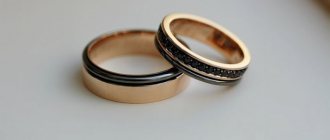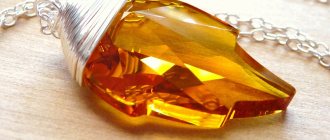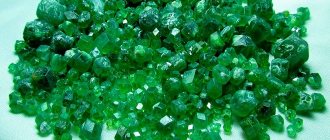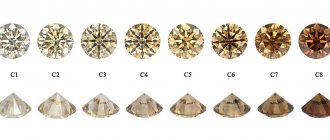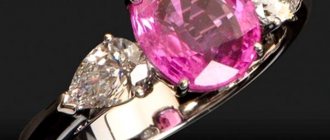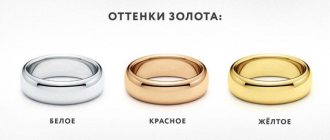“What types of gold are there?” - This is one of the most popular questions asked by buyers who love unusual things. We answer: there are at least a dozen types of gold flowers, but not all of them are used for the production of jewelry. Some alloys are not suitable because they are brittle, others because they are expensive.
However, when we talk about how many types of gold there are, we are actually discussing the number of shades of its alloys. Pure gold always has a sunny yellow color; the Latin name of this chemical element, aurum, means “yellow.” Well, the shade changes after adding a ligature - components that give the naturally soft precious (noble) metal the strength necessary for the production of jewelry.
Yellow gold
Yellow is an alloy of Au with copper and silver. Such an alloy can be either 585 standard (i.e. with 58.5% pure Au) or 750 standard (with 75% precious metal). Depending on the proportions of the ligature, the shade changes: add more silver and you get a color that is commonly called “lemon.” Well, copper adds warmth to the jewelry palette. Of all the types of gold colors, it is the yellow 750 alloy that is most often used in Europe for the manufacture of wedding rings. Gradually the fashion for it comes to Russia. Appreciate the beauty of yellow alloy in a designer diamond ring.
Red gold ring with hearts and inserts 911633K
Combined rings with a path of diamonds 931479B , without inserts 931479
Designer ring made of lemon gold 931638B
White gold
The choice of types of gold in jewelry often depends on the stones that will be inlaid in it. The white alloy became popular thanks to diamonds. When they learned how to cut them with high quality, they noticed that the maximum play of light in the edges occurs when diamonds are framed with platinum. To make the frame more affordable, they began to use a white gold alloy. Its alloy is variable, for example, it can consist of 10.5% copper, 12.5% silver and 27% palladium. In general, for whiteness they can add:
- silver is a noble metal;
- palladium is a noble metal of the platinum group;
- platinum is a noble metal of high value, which makes the alloy more expensive;
- cadmium is toxic, prohibited for use in the Russian Federation;
- Nickel is practically not used today, as it can cause local allergies.
Few people know, but white types of gold in jewelry are actually not completely white in color - they are yellowish, because the base metal in them is yellow. Well, the sparkling platinum effect is given to the jewelry by rhodium plating, that is, coating with another precious metal - rhodium. See how these diamond earrings in white rhodium gold play out. Natural white color looks less bright, as in this two-color gold ring. At the same time, natural white is increasingly popular in Europe. It is likely that in Russia it will also soon reach the TOP, at least in the category of rings, because rhodium plating wears off over time due to mechanical stress, and it needs to be renewed.
White gold earrings with pearls (made by Diva, St. Petersburg)
Ring of several rings made of white gold (made by Diva, St. Petersburg)
White gold necklace with stones (made by Diva, St. Petersburg)
What color of gold does diamonds look best in?
The traditional setting for diamonds is white gold. This trend was set by Tiffany when, in 1886, Charles Lewis Tiffan patented a white gold engagement ring with a single diamond set with a crown of prongs. The white metal brings out the cool shine of the diamonds, and the setting and stone begin to work as one. But diamonds with a tint can look great in yellow, red, rose or even green gold.
The compatibility of metal and stone is an important component in the manufacture of any jewelry. Our showroom presents products whose design has been thought out to the smallest detail, including gold and diamond shades. The assortment includes rings, earrings, pendants made of white and yellow gold. The quality of the products is confirmed by all necessary documentation in accordance with the legislation of the Russian Federation. The frames have the hallmark of the Assay Office; all products are accompanied by a passport and a diamond certificate from the independent gemological center of Moscow State University.
Pink gold
If we compare the types of gold in jewelry by prestige, then pink will take honorable first place. World-famous jewelry houses offer jewelry made from pink alloy. In pursuit of prestige, some Russian mass-segment companies began to call red alloys pink, which completely confused the consumer. The concept is not legally established, and therefore, by calling the alloy pink, they do not violate the law.
In the strict sense of the term, rose gold is always 750 fine. In fact, it is red, but with a reduced content of the alloy of the same composition due to the high purity of the precious metal. Typically, the additive consists of 9% silver and 16% copper.
Red gold
If you are in the USA and ask what types of gold exist, red may be on the list, but it will look unusual. In America, it is customary to call red an alloy that is not used in Russia - 50% gold and 50% copper (12-karat). But in Europe, when asked about red gold, they will most likely shrug their shoulders. But if you ask about Russian gold, they will show you jewelry in a color familiar to every Soviet person.
In the classic “Soviet” version, 585-grade metal contains 58.5% Au, 31.1% copper and 10.4% silver. The composition of the alloy is the same as in the yellow alloy, but the proportions are different. This is the perfect backdrop for colored gemstones - rubies, emeralds, sapphires: appreciate the effect in gold earrings with a ruby trefoil. The red alloy is practical because it does not have rhodium plating, which can wear off, and contains 41.5% ligature, which makes the jewelry durable.
The type of gold you choose depends on your preferences.
Modern technologies make it possible to obtain types of gold and alloys of completely different shades, varying the proportions of metals in different ways. It all depends on the wishes of jewelers, designers and customers of products.
We hope that we have been able to clarify in more detail what the differences are between types of gold, for example, how yellow gold differs from red gold, why white gold is more expensive than others, and how gold hallmarks differ.
This information will help you quickly and efficiently decide on the choice of gold, and understand what alloy you would like to create or purchase your jewelry from. You can learn how each of these alloys should be processed, and what are the nuances when making jewelry from different gold alloys, in our “YES, I Can” jewelry school in the “Jewelry Making for Beginners” course. You can find out more about the course on the course page
Green gold
We open the list of exotic types of gold flowers with a green alloy. It is produced by adding silver, copper, potassium, zinc, rubidium and sometimes cadmium in varying proportions. The last element is a toxic substance, even in small doses. Today, its use in the production of jewelry is prohibited in the EU and Russia. Therefore, it is not advisable to buy green gold jewelry produced in countries other than the EU or the Russian Federation. Depending on the composition of the ligature, the green color can be rich, weak or yellowish-green.
Black gold
What type of gold is the most expensive? Black. But only if it is an alloy of precious metal with cobalt and chromium. These elements are difficult to connect, the technology is kept secret, which is why the cost of the exclusive soars. However, some manufacturers have invented more accessible ways to change the color of gold items to black:
- galvanic rhodium plating (rhodium can be not only white);
- ruthenium electroplating;
- patination with sulfur and oxygen.
Thus, only the surface of the product becomes black. Over time, the black layer will be erased.
Types of gold
In the territory of the modern Caucasus, gold began to be mined back in the 3rd millennium BC. The method was this: the skin and wool were immersed in the river. Large particles of loose metal, carried by the flow, became entangled in it. As a result, golden fleece was taken out of the waters, because it was sheep skins that were used. So the Golden Fleece myth has a historical background.
During the times of Ancient Greece, there was one type of gold - yellow. This is the natural color of the element. In nature, metal does not come in other tones. In the 21st century, there are several types of jewelry. The main qualification is by color. People have learned to change it by adding a ligature to gold. This is what they call impurities. They also improve the performance properties of the metal, because in its pure form it is too soft.
Two types of gold besides yellow have already become classic. The first type is red alloy. The color of the yellow element in it is changed due to the addition of copper. This type of gold is also called chervonets, because in tsarist times in Rus' coins called chervonets were cast from it. And they, in turn, are named after the natural dye niello. This plant pigment was red.
The second classic type of gold is white. The color of the base metal in it changes the alloy made of platinum, palladium, nickel or silver. There is no nickel in foreign products. Abroad, its use is prohibited by law, since the metal is considered an allergen.
For now, non-ferrous varieties of the noble metal are considered unusual. Their recipe is still at the development stage and is imperfect. Almost every major brand has its own formula of colorful alloys. The secrets of the formulas are not revealed because they compete for buyers of rare green, blue, and black gold. Well, first things first.
— Green gold requires mixing with palladium, silver, zinc, and potassium. Proportions are important, otherwise you will end up with a white alloy, or it will remain yellow.
— The metal acquires a blue color in combination with indium, cobalt and rhodium.
— The purple alloy contains aluminum or potassium. It is worth considering that the colorful types of gold in the photo often have only a tint, and not a rich color. The products look the same in real life. Bright purple specimens of the unit. The secrets of their production are kept secret. Some jewelers accuse their colleagues of simply superficially coloring gold alloys. In other words, under the thin top layer there is metal of the usual yellow, reddish, and white colors. Otherwise, the craftsmen suspect, it is impossible to give gold a rich tone.
— Black gold appeared on the market last among all color variations. To obtain the new item, the yellow element was fused with cobalt and chromium. Simple mixing is not enough. The alloy is oxidized at high temperatures, which is the only way to obtain a black color.
Types of gold are also divided into noble and ignoble. The latter are considered to be alloys of precious raw materials with base, allergenic, waste metals. These include, for example, zinc, nickel, and tin. The latter, by the way, is often added to gold alloys secretly, without notifying the general public about it. Tin makes gold much heavier, and as a result, you can sell less yellow metal and earn more.
The noble ones include gold with a ligature of the same precious elements - platinum, silver, rhodium, palladium, iridium. Their presence in the alloy makes it much more expensive than base variations.
Gold is also divided according to its intended purpose, just like the types of gold rings . There are wedding rings, anniversary rings, signet rings and engagement rings. All these jewelry are made from gold jewelry. It is never pure. It always contains a ligature so that the products are durable and durable. The pure metal is gold bullion, the currency option traded by banks and stock markets. The bullion metal is 999 fine, that is, the impurities in gold are no more than 1%.
Church gold or gold leaf are also available. It is also, usually, of the highest standard, but rolled into thin sheets like foil. They cover walls, domes, icons and other temple utensils. There is a technical metal used in the production of equipment and electronics.
The famous phrase “all that glitters is not gold.” But, in the 21st century, the statement “all that is yellow is not gold” is also relevant. The sunny color has ceased to be a distinctive feature of the precious element. Moreover, non-precious twin alloys have been invented. For example, Mannheim gold completely imitates the yellow metal - a combination of copper and zinc.
Types of gold and price
Is there a connection between types of gold and its price? If we talk about classic alloys (red, white, yellow and pink), the difference in the price of the alloy is not so significant as to affect the final cost of the jewelry. Yes, a white alloy ligature costs a little more, since it contains more silver, and sometimes platinum is also included in it. Yet manufacturers usually offer a single price for jewelry, regardless of what types of gold were used in its manufacture. If you want something exotic, you will have to pay more for it. Not because the price of the ligature is higher, but because of the exclusivity of such a product.
The Diva jewelry factory offers gold jewelry of 585 and 750 samples made of yellow, white and red alloys. Our designers select the optimal shade of metal to highlight the beauty of natural precious stones. We use a safe ligature that does not cause allergic reactions. By purchasing Diva jewelry, you are buying the best!
What types of gold exist and what are their differences?
You probably noticed that every piece of gold jewelry has a special designation - hallmark. This is always a set of three numbers: 375, 585, 750 and others. The hallmark on the jewelry indicates the purity of the gold alloy - this is the ratio of pure metal to impurities, called alloy.
A mineral mined in nature cannot be immediately used to create jewelry. Natural gold contains particles and impurities of other minerals, and in order for such raw materials to become a noble metal, multi-level purification is needed.
The purest gold sample contains 99.9% of its content per gram. Such gold is used, for example, by banks. A bank bar contains 999 grams of gold per kilogram of alloy. Such absolute purification has been used recently and is expensive.
When creating jewelry, other types of samples are used that contain not pure gold, but combinations of metals and impurities. Silver, copper, zinc, cadmium and other metals are used as alloys.
In Europe and the USA, the karat system is used to determine the standard, where the number 24 denotes the purest gold.
375 standard (9 carats) and 500 standard (12 carats)
This alloy contains 37.5% pure gold. Such products are of low quality. In this case, the original aesthetic appearance of the products is quickly lost under the influence of external factors.
375 and 500 samples are not used in the manufacture of jewelry.
585 standard (14 carats)
The most popular alloy used in jewelry making. It is distinguished by decent quality and at the same time an average price. The ligature can be very different: 585 alloys contain copper, silver, zinc and platinum.
750 sample (18 carats)
The gold content in the material is at least 75%. This alloy is more expensive than 585 gold, but jewelry made from it looks very aesthetically pleasing, is of high quality and wear-resistant.
900 standard (21.6 carats)
In Russia, bank coins are made from 900 fine alloy. The alloy is also used in medicine for installing crowns and dentures. This test is most common in China, the United Arab Emirates, Turkey and Thailand.
958 standard (23 carats)
One of the most expensive alloys, since a very small percentage of it consists of impurities and alloys. Most of the alloy is pure gold. There is also 985 test, but this alloy is used extremely rarely, as it is easily deformed and is characterized by increased elasticity.
Alloy composition
How does the chemical composition of an alloy affect its mechanical properties? You can learn this in our course "Jewelry Making for Beginners"

